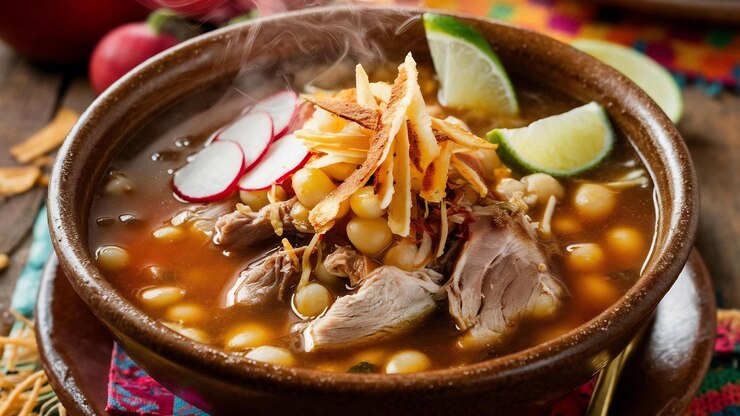Pozole is more than just a dish—it’s a deeply rooted cultural experience that has stood the test of time. This hearty, traditional Mexican stew is cherished for its bold flavors, historical significance, and versatility. Whether served at festive gatherings or enjoyed as a comforting family meal, continues to capture the hearts of food lovers around the world.
What Is Pozole?
Pozole (pronounced po-SO-leh) is a savory soup or stew made primarily from hominy—dried maize kernels that have been treated with an alkali in a process called nixtamalization. Typically slow-cooked for hours, it is combined with meat (often pork or chicken), herbs, spices, and various toppings to create a flavorful, satisfying dish. has three popular variations: rojo (red), verde (green), and blanco (white), each named for its color and ingredient base.
The Origins of Pozole
Pozole dates back to pre-Columbian Mesoamerican times. The Aztecs prepared a similar dish for sacred rituals, often using human meat as an offering to the gods. After the Spanish conquest, pork replaced the human flesh, and the dish evolved into what we now know as. Despite its dark origin, today it symbolizes unity, celebration, and cultural pride in Mexican households.
Types of Pozole and Their Unique Characteristics
Pozole comes in various regional styles, each offering a distinct taste and visual appeal. Here’s a breakdown of the main types:
1. Pozole Rojo (Red Pozole)
This version uses red chiles like guajillo or ancho to create a deep, smoky broth. It’s typically made with pork and garnished with lettuce, radishes, onions, oregano, and lime.
2. Pozole Verde (Green Pozole)
Originating from the state of Guerrero, this version incorporates green ingredients such as tomatillos, cilantro, and green chiles. Chicken is commonly used in verde, offering a lighter, herbaceous flavor.
3. Pozole Blanco (White Pozole)
The simplest form, white has no added chiles and relies on the richness of the meat broth and hominy. It’s a popular base for people who like to add their own toppings and salsas for flavor customization.
Key Ingredients That Make Pozole Special
While recipes can vary, the base ingredients of remain consistent:
-
Hominy: The heart of the dish. Its chewy texture and mild corn flavor are essential.
-
Meat: Typically pork shoulder, though chicken or a mix is also common.
-
Chiles: Depending on the type these can be red, green, or omitted altogether.
-
Garnishes: Fresh toppings like shredded cabbage, radishes, avocado, lime wedges, and oregano are key to balancing the richness of the stew.
How to Make Traditional Pozole at Home
Making pozole at home requires time, patience, and love. Here’s a simplified overview of how to prepare it:
Ingredients:
-
2 lbs pork shoulder (or chicken)
-
2 cans hominy (or dried hominy pre-soaked and boiled)
-
3-4 dried guajillo or ancho chiles (for rojo)
-
1 onion, chopped
-
3 cloves garlic
-
Salt and pepper to taste
-
Toppings: shredded cabbage, radishes, onion, lime, oregano
Instructions:
-
Boil the meat in a large pot with garlic, onion, and salt until tender.
-
In a separate pan, soften the dried chiles in hot water, then blend them into a smooth paste.
-
Add the chile paste and hominy to the pot.
-
Simmer for at least one hour to allow flavors to develop.
-
Serve with garnishes and warm tortillas on the side.
This version can be modified for green or white simply by changing or omitting the chile ingredients.
Why Pozole Is a Staple at Mexican Celebrations
Pozole is a popular dish for special occasions like Mexican Independence Day, Christmas, and birthdays. Its ability to feed a large crowd, paired with its deep cultural significance, makes it a go-to meal during holidays. The act of preparing is often communal, with families gathering to chop vegetables, prepare toppings, and stir the pot—a true expression of love and unity.
Health Benefits of Pozole
While it may seem indulgent, can be surprisingly nutritious. It’s high in protein, thanks to the meat, and offers dietary fiber from hominy. Toppings like cabbage, radish, and avocado add vitamins and antioxidants, making it a balanced and hearty meal. Opting for lean meats and reducing sodium can make an even healthier choice.
Pozole in Modern Cuisine
In recent years, has gained popularity beyond Mexico. Restaurants across the U.S. and Latin America are serving modern takes on the classic dish. Vegan and vegetarian versions are also emerging, substituting meat with mushrooms or jackfruit and using vegetable broth. This adaptation keeps the soul of intact while catering to changing dietary preferences.
Tips for Serving and Enjoying Pozole
-
Garnish generously: The toppings add texture, color, and freshness to each spoonful.
-
Pair with sides: goes well with tostadas, lime wedges, and spicy salsas.
-
Make it ahead: tastes even better the next day after the flavors have melded.
Final Thoughts on Pozole
Pozole is not just food—it’s tradition, culture, and comfort in a bowl. With its rich history, versatile flavors, and hearty ingredients, it continues to be a beloved dish in Mexican cuisine and beyond. Whether you’re enjoying rojo on a chilly evening or preparing verde for a celebration, one thing is certain: this dish will leave a lasting impression.






